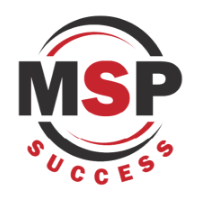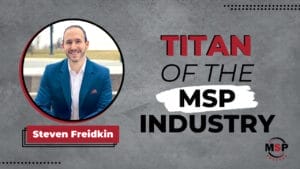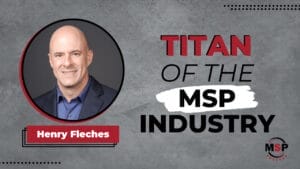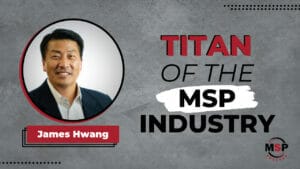The IT Landscape Is Ever-Changing, But Jason Waldrop, President Of Managed Services Division For IT Industry Titan Red River, Shares His Critical Keys To Success For MSPs That Want To Accelerate Their Growth Now
Note: This article is taken from a live interview and has been edited for clarity and length.
Jason Waldrop reached an exciting but pivotal point in his career: his MSP had grown into a regional powerhouse. Jason didn’t want to stop there, but to grow beyond his geographical base, he needed a strategic solution that would propel the company to new heights in the industry. Ultimately, Jason made the game-changing decision to sell to Red River, which has since become a global industry titan.
Robin Robins, founder of MSP Success Magazine, spoke with Jason to uncover the brilliance behind the acquisition, as well as how MSPs of any size can be resilient in the face of widespread challenges like a limited labor market. Jason also shares why grit is necessary to successfully accelerate an MSP to next-level growth and the three factors he says are crucial to the success of any MSP that wants to scale up and carve out their own place as a titan in the industry!
Robin Robins, Founder, MSP Success Magazine and Big Red Media: You started an MSP – your typical SMB: butcher, baker, candlestick maker and Kaseya shop – but tell me about your background and story. How big did you get your MSP before merging with Red River?
Jason Waldrop, President, Red River Managed Services Division: In the early days, we were a traditional small business VAR. Then, in the late ’90s and early 2000s, we got into Voice over IP and eventually ended up managing customers’ servers and their desktops. Then, Kaseya launched AutoTask and ConnectWise behind that, and everything started to come together. We rode that wave, and along the way, we built a data center and significant collaboration practice.
By 2019, our company was a major regional MSP. We had a couple hundred employees and were growing at scale with acceleration. We knew we needed to do something with the business, whether taking on private equity investment directly, taking on debt or a strategic combination of both. Ultimately, we ran an investment banking process and landed with Red River. It was a perfect one-plus-one-equals-three fit because Red River was predominantly public sector and VAR and we were predominantly commercial and managed services. You take those scaled-out operations and bolt them together, and we’ve been able to cross-sell into markets and develop new services just because of our scale. The acquisition has really worked well.
Robin: M&A is huge in our MSP industry. We see MSPs roll up, sell, buy or merge daily. From your perspective, how does an MSP owner know when to consider M&A for their company?
Jason: It’s such an individual answer. When I’m talking to business owners about what they should do with this precious thing that they put all their time, energy and money into for years, I always say the best deal is the one you’re happy with.
When we were acquired four years ago, I had a long runway ahead of me. I wanted to keep going for a while, so I was looking for someplace to hang my hat and grow with scale. But some folks are at the end of their career and need to make sure the business has an enduring legacy and winds up in the right hands, while others get tired of running a business. There’s a whole host of motivators, and those motivators are going to drive different outcomes depending on the situation.
When I was considering my options, one of my mentors said to me, “Don’t do anything until you know what your next move will be. You’ll have a considerable non-compete in front of you and be off the field for many years if you choose not to go along with the acquisition.” I think it’s good advice and I encourage MSPs to consider this in their process too.
Robin: So, you ultimately sold your MSP to Red River but stayed on as president of the Managed Services Division. How has Red River changed since the acquisition?
Jason: Before I sold my MSP to Red River, we were a Kaseya 1.0 shop and did SMB business. Today, we still have a nice SMB vertical in the practice, but over the years, our business has moved more into the mid-market. We have a half-dozen verticals, one of them being SMB and five others that are Russell 2000 and public-sector-type businesses, which is where we do most of our business from a topline perspective.
Today, we’re organized into three units: VAR and technology solutions, managed services and our programs division, which is a public-sector business made up of mostly SLED and federal organizations buying enduring service contracts with us. Within those three business units, we focus on four technology areas: cloud, cyber, collaboration and infrastructure.
Robin: Right now, a lot of MSPs want to grow but are struggling with challenges like inflation and labor shortages. They are scared to hire a salesperson because it might work but they don’t have the engineers to keep up. What do you see as the toughest challenges for MSPs to deal with today? How are you overcoming them?
Jason: There’s no question that labor and staffing are hard. It’s not a new story. That is where the most intense pressure is on the business, and it kind of comes from two perspectives. One is just talent acquisition and retention. We’re a 24/7 operation, so you’re going to have more churn.
But the overlay to that is work-from-home in a post-Covid environment, where you have to be so incredibly intentional about culture. We used to have service desk, and NOC guys work in the office, and you could walk into that room and just feel the energy. You could put your arm around folks and mentor them. We try to get them back to the office, but it’s hard. We hired all over the country during Covid and took advantage of our ability to hire out of geo.
My concern is that early-in-career folks aren’t aware of what they’re missing right now. Sitting in a team next to senior folks, hearing how they behave on a call, getting mentored in real-time as they’re working a trouble ticket or something, and all that stuff that happens when you’re in the office. I worry they are missing hallway conversations and hanging around the coffeepot, and it’s going to be costly as they try to navigate through their careers and costly for businesses like ours that need to scale.
The most effective way for us to scale is to hire into the NOC shift, the overnight guys, bring them into a client team, and then turn them into subject-matter experts over time. If they’re not in the office, it’s hard to make those progressions. You have to be very intentional about it, but it’s hard work.
Robin: Is your strategy to hire people to work in the office and make exceptions for remote work, or are you embracing remote work?
Jason: Let’s face it, folks have changed the way their lives are set up. People have set themselves up to drop the kids off at the bus or pick them up from school, or whatever it is. It’s unfair for a business to turn around and ask them to upend all the things they’ve wired into their families for the last couple of years. That balance is not easy.
But like many companies, we’re beginning to have back-to-office conversations. Chuck Robbins put it well when he said, “We want the office to be a magnet, not a mandate.” We’re trying to do that as well. Instead of saying, “You must come into the office,” we’re saying, “Bring your teams in for these types of meetings,” or “Every Wednesday, there’s coffee and food on the company,” to try to get folks excited about working a day in the office.
Robin: What other headwinds are you up against? Have you seen any slowdowns in business?
Jason: The #1 challenge is talent, like we just talked about. On the business side, we’re doing a fairly good job with sales and growth and with revenue. We’re not seeing it slow down, and I have considerable growth targets put on my business from our board. They have effectively said Red River will do whatever you need us to invest to deliver those growth targets. There’s a strong belief that this market has a long way to go, especially being in the Russell 2000 mid-market commercial space, where it’s difficult for the Globals, Capgeminis and Wipros to come down and compete. It’s also hard for the SMB guys to come up, so there are not many of us that have a very broad portfolio that’s enterprise-ready.
Fred Voccola from Kaseya will tell you every day that is where the most action is because 1) it’s an unsolved market, and 2), it’s the last market to outsource. The middle market that held on to their IT departments for so long is finally saying, “Okay, we have to take on some or all of this and bring a third party in to help.”
There are some outsourced verticals in that market that are hot right now, like cyber, cloud and the service desk. Cyber, cloud and collaboration are where we’re able to create sort of asymmetric outcomes for our customers. In other words, we can bring them things that are very difficult for them to do in-house. We’ve got these highly curated offers around advanced Office 365 services that customers can consume in a very economical manner at scale.
It’s just part of how we go to work every day. Similarly, with cyber, we have a whole suite of what I’d characterize as very pragmatic. It’ll solve 80% of your cyber problems every day, and customers appreciate that. What we see in commercial is that they are less focused on the specific OEM or the specific technology; they’re more focused on an outcome with an attached SLA.
Robin: What you’re doing is remarkable, but let’s say you’re a million-dollar MSP. You don’t have the bench, staff or funding you do at Red River. What’s your three-to-five-year plan?
Jason: The guys starting today have a distinct advantage over us old geezers when we started. The reason I say that is that this is now a mature industry. You can go to a company like Kaseya, for example, and get everything you need to run an MSP under one tent. The tooling is much more mature and ready to go than it used to be. Also, cloud has changed the game specifically for down-market MSPs. Every down-market customer is going to be on Microsoft 365, using Windows or Mac, and everybody’s comfortable with AWS and Azure. The universe of technology that an MSP must be good at is much more finite and should allow for specialization and take a lot of the friction and cost out of what used to be difficult from a scaling perspective.
I think they can say yes a lot more. We used to say no more often than I wanted to just because we weren’t experts at some esoteric storage array or something a customer had just bought and wasn’t going to get rid of. I think there’s a lot of opportunity if you have a young MSP to build scale because of some of the innovation that’s happened not only in our business but from the hyper-scalers and SaaS providers.
Robin: MSPs will argue it’s not easier – it’s every bit as hard today. The competition is tough. With that idea, what would be your marketing and sales strategy? You mentioned specialization. Is that where you would play?
Jason: I used to joke that our vertical was folks who had a budget for the things we sold. We’re bigger now so we think differently about this, but the good news about this business is there are a lot of ways to do it. If you are going to be an SMB MSP, that’s a vertical all by itself. There is nothing in the world wrong with that.
Alternatively, you could say, “You know what? I am going to make a bet that medical practices are going to have technology transformation issues for the next 10 years because the regulatory compliance regime is coming their way, and because of the cost pressures that are being put on them by the insurance companies and reasons XYZ to support that strategy. Not only am I going to be good at delivering core IT, but I’m going to get good at this EMR platform. I’m going to learn to speak the language that medical professionals lip-talk every day with their clients, so I can be very credible and build an at-scale vertical business.”
But at the core, have a good technical solution, learn how to hire and manage good salespeople and market your business. If you do those things, you can have a successful MSP and probably any other regional services business. If you can figure out how to assemble a good delivery team and assemble and manage a good marketing operation, those are the critical keys to success, whether vertical or horizontal.
Robin: You mentioned Fred and Kaseya earlier. Whenever we talk about selling, MSPs tend to focus on the tech. They get fixated on this or that vendor. So, I’m curious what your thoughts are on Fred’s vision of bringing all the tech into one platform? Talk to me about that vision and why you’re a Kaseya shop.
Jason: What Fred’s done speaks for itself. If you look at the strategy he’s built, he’s made a handful of very smart acquisitions that are almost universally working. How many other CEOs can say that virtually all the acquisitions they’ve made have plugged in and worked?
He’s acquired these businesses the right way too. Think about where Kaseya was before they brought Fred to the table and where the company is now. It’s the default RMM platform with all these little ornaments he’s hung around that. As an MSP, if you can have your core services consolidated around one engine, there’s going to be more automation opportunity and there are fewer clicks for your technician in a ticket. All that will drive a better, more efficient outcome for your client and drop more money to the bottom line for the business. Said that way, it’s kind of obvious why there’s been success at Kaseya under Fred’s leadership.
Robin: I want to tell you congratulations, you are in the 1% of our industry by far. No small feat, truly. And you’re still in your prime! But if you were giving advice to smaller MSPs who are trying to grow, make more money and be excellent in the industry, what would you tell them? What are the things that helped you get to where you are today?
Jason: When you’re an entrepreneur and growing a business, grit is a must. The highs are very high, and the lows are very low. There is always some problem, and it’s on your desk, right? You have to be able to grit through that stuff.
I also think about business maturing in stages. A good technical team can attract some customers and serve them well for a while, but at some point you have to figure out your sales and marketing if you’re going to get big. I speak on a number of advisory panels in our industry, and I’ve mentored a lot of folks who are growing an MSP. I see many of them stall when they have to figure out how to hire a sales and marketing engine and grow the business.
We’re going through it right now. We’re scaling, and I can’t hire new salespeople fast enough. I’ve got a limitless appetite from my board to invest in salespeople to grow our business. We’re a big business; they want me to grow at a big rate for the next five years. The ability to do that, once you’ve got your mousetrap built, is sales and marketing.
If you’re a small MSP and building something that you have large aspirations for, I would say figure out your mousetrap and then really figure out how to sell it.






